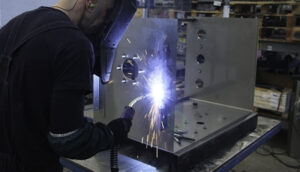Sheet metal, which is made up of thin and flat bits of metal either steel or aluminum is used extensively in the building and manufacturing industries. It is used in the construction industry as panels for buildings and homes. Sheet metal is used in the automotive industry for a variety of purposes such as vehicle parts, heavy equipment, floors, and so on.
What Is The Sheet Metal Forming Process?
Companies, on the other hand, often use one or more of the following forming processes when producing sheet metal.
1) Shearing and Cutting
Shearing is the best way to split a big sheet into smaller rectangles. The shearing machine, which looks like a giant pair of scissors, has a long blade that makes a straight cut through the sheet.
We frequently use laser cutting to cut out more complex shapes. Our laser machines are capable of producing intricate metal blanks that are ready for bending.
Another method for forming complex shapes in sheet metal is punching. Punching, strictly speaking, is a method for creating holes in a board, but by nibbling on a turret punch (making a series of joined holes), we can punch out a complex shape.
Secondary cutting operations are rarely needed for laser or turret punch blanks. Rectangular sheets coming off the shears would normally need holes punching or drilling, as well as corner notching until we can bend them.
2) Bending
The majority of sheet metal bending is performed on a system known as a press brake. The operator places the sheet so that the bend line is above a vee-shaped channel, then lowers the bending tool.
This forces the sheet into the vee, and the sides of the blank rise as the bend are shaped.
Managing spring back is one of the most difficult aspects of bending. This is when the metal seeks to return to its original flat form.
Overbending is used to deal with it, but having the bend to finish at exactly the right angle needs expertise and practice.
Some metals harden as they bend, which can cause cracking. Furthermore, the rolling process imparts grain to the sheet metal, which influences how it bends.
3) Assembly
Fit-up is the first step in putting the puzzle together. Each component of the assembly is kept in place with clamps or fixturing as required.
Tack welds are then used to keep it intact. Only then are the long welds that connect the pieces formed.
We use a range of arc welding equipment, as well as robot welding cells when necessary.
Welding is not needed for every customer or job. Riveting, screwing, or bonding may be more suitable depending on the final application. The benefit is that if a component is destroyed, it is easier to repair.
4) Laser Cutting
In recent years, laser cutting has become a more popular sheet metal forming technique. Sheet metal is exposed to a high-powered laser, which burns holes in the metal during laser cutting.
It is a quicker and more accurate cutting process that can also be done automatically with the help of a computer numerically operated (CNC) laser cutting system.
5) Hydroforming
Hydroforming is a lesser-known sheet metal forming technique. Hydroforming, like deep drawing, entails extending the blank over a die. So, what exactly is the distinction between hydroforming and deep drawing?
The primary distinction between these two processes is that deep drawing necessitates several draw reductions, whereas hydroforming is completed in a single phase.
6) Punching
Finally, punching is a sheet metal forming method that uses a punch and dies collection to make holes in sheet metal.
Sheet metal is sandwiched between the punch and die. The punch then pushes down and through the sheet metal to make a hole.
7) Finishing
Most fabrications are finished after they have been assembled or joined. This includes everything from washing up welds to polishing to a mirror finish (like truck bumpers).
There are a variety of painting and coating choices available between these two extremes. These typically have two goals: to protect the fabrication from corrosion and to provide whatever finished appearance is needed.
Sheet Metal Forming Tools
1. Angle Grinder
Also known as a disc grinder or side grinder, is used to cut, grind, sharpen, sand, and polish various types of metals.
2. Throatless Shear
This cutting tool helps you to accurately and easily create straight, angled, and irregular cuts in a metal sheet.
3. Corner Notcher
This sort of cutting tool is used to notch the corners of various sheet metals. The notcher is operated by hydraulics.
4. Planishing Hammer
This metal shaping tool is used to finely form, flatten, straighten, and smooth the surface of different metal sheets.
5. Flange and Punch Tool
This punching tool profiles different metal sheets and produces holes along the material’s edges.
6. Shrinker and Stretcher
This is a metal shaping tool that can be used as a shrinker as well as a stretcher. This tool’s primary function is to shape curves on sheet metal.
7. Cleco Fasteners
Cleco fasteners are temporary fasteners that keep sheets of material or other pieces together until they are permanently joined, such as frames or stiffeners.
When it comes to metal fabrication, the right tools are important. Most of the time, it is up to a professional metal fabricator to determine which tool is best for the job.
Baseline Custom Fabricating employs metal fabricators who are experts in their field who use cutting-edge technology. To learn more about our procedure, contact us today.




